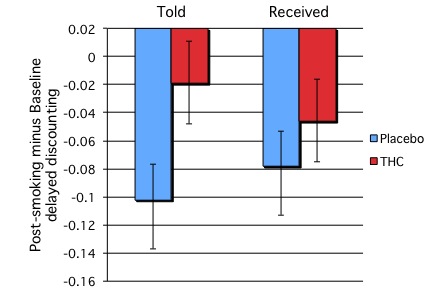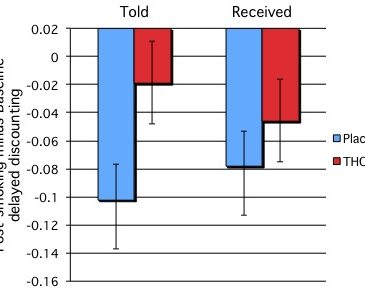Marijuana use is associated with risky behaviors, such as risky sexual behavior; and some dangerous outcomes, such as motor vehicle accidents (Drummer et al., 2004; Fernandez et al., 2004). However, it is not clear how individuals’ expectations about the experiential effects of marijuana use might play a role in elevated risk taking behavior; expectations in general exert powerful effects on behavior (e.g., Testa et al., 2006). This week’s STASH reviews a study that investigates the separate effects of true marijuana taking and marijuana expectancy on risk behavior and impulsivity (Metrik et al., 2012).
Methods
- Researchers recruited 136 marijuana smokers through flyers, newspaper advertisements and social media websites to participate in a marijuana use study.
- At baseline participants were randomly assigned to one of 4 conditions:
- 1) Told THC /Received THC; 2) Told Placebo/Received Placebo; 3) Told THC/Received Placebo; 4) Told Placebo/Received THC.
- Researchers told participants in the “Told THC” conditions that they would be smoking an active marijuana cigarette that contains THC (i.e., delta-9-tetrahydrocannabinol). Researcher told participants in the “told Placebo” conditions that they would be smoking placebo cigarette without any THC.
- Participants in the “Received THC” conditions smoked a cigarette that contained 2.8% of THC. Participants in the “Received placebo” conditions smoked a cigarette that contained no THC until the ash reached 10 mm from the end.
- At baseline, participants also completed several tasks including following:
- Impulsive Disinhibition: Participants completed the Stroop Color-Word task. In the Stroop task, longer response times to stimuli on a computer screen indicate greater difficulty suppressing an instinctive behavior.. In this study the researchers measured reaction time as well as the number of correct responses to color-congruent trials (e.g., the word “blue” written in blue font) and color-incongruent trials (e.g., the word “blue” written in red font).
- Impulsive Decision-Making: Participants completed the Experiential Discounting Task (Reynolds & Schiffbauer, 2004). In the EDT, participants decide whether to accept a series of monetary rewards that vary in their size and delay. Some people devalue, or discount, larger rewards which are further away in time as compared to smaller, immediate rewards; this delay discounting is believed to mark impulsivity (Reynolds & Schiffbauer, 2004). The outcome variable based on participants’ decisions varied from 0 (i.e., greatest delay discounting) to 1 (i.e., no delay discounting).
- Ninety minutes after smoking, participants completed the tasks again as well as a manipulation check that asked about suspicions about THC content. For the EDT, the researchers subtracted baseline score from the post-smoking score. More negative difference scores indicate a larger increase in impulsivity after smoking.
- The researchers also measured subjective intoxication with the ARCI-Marijuana scale (Chait, Fischman, & Schuster, 1985) 12 minutes after smoking and following the impulsivity tasks.
Results
- Two participants (6%) reported suspicions about THC content in the Told THC/Received Placebo condition and seven (21%) in the Told Placebo/Received THC condition. 1
- Both consuming THC (F (1, 125) = 77.23, p < .001) and having the expectation of consuming THC (F (1, 125) = 6.32, p < .05) increased subjective intoxication.
- The researchers used linear regression to test the effects of pharmacology and expectations on the Stroop Color-Word and the EDT task. They entered the baseline value in the first step, followed by the main effects of pharmacology and expectancies on the second step, followed by the pharmacology by expectancy interaction on the third step.
- For the Stroop Color-Word task, the researchers observed no main effect of expectancy and no interaction between pharmacology and expectancy. Pharmacology had a significant main effect on the number of correct responses for color-incongruent trials(Β = -1.28, p < 0.05), but not for color-congruent trials. Participants who consumed THC made more errors on color-incongruent trials. Pharmacology had no effect on response time.
- A different pattern emerged for the EDT; pharmacology did not exert an effect but expectations did (Β = 0.09, p < 0.05). Those in “Told THC” conditions discounted delayed rewards less (i.e., made less impulsive choices) than those in “Told Placebo” conditions. Figure 1 presents the EDT difference scores among the four conditions.

Figure. Difference scores (Post-smoking minus baseline) in delayed discounting task as a function of pharmacology and expectations. Click image to enlarge.
Limitations
- The researchers used computerized tasks to assess impulsivity. As with any well controlled experiment, the generalizability beyond these measurements may be questionable due to limited external validity .
- For ethical reasons, participants in this study only included current marijuana smokers. The effect of marijuana on occasional smokers is not clear.
- Again, for ethical reasons and also to conceal the placebo, the experimenters had to give only small doses of THC. The effect of larger doses is unclear.
Conclusions
In this study, taking placebo increased subjective feeling of intoxication. This demonstrates that expectancy may play a substantial role in individuals’ perception of the drug effect. Further, expectations influenced some aspects of impulsive behavior, but in a surprising way. Individuals who believed they consumed THC were more cautious in their decisions. Specifically, they discounted delayed reward less then did those participants who believed they used placebo. This signals a compensatory effect (Bates & Blakely, 1999); individuals who believe they are under influence of drug might deliberately try to compensate for its potential effects and practice more caution.
Consuming THC did not influence the main impulsivity outcome. This implies that the effect of marijuana on impulsivity is not as strong as the effect of other drugs (Fillmore, 2003). This result, as with all research, should not be automatically generalized beyond the particular setting and interpreted as a proof of no effect of the drug on impulsivity and risk perception.
– Julia Braverman
What do you think? Please use the comment link below to provide feedback on this article.
References
Bates, M. N., & Blakely, T. A. (1999). Role of cannabis in motor vehicle crashes. Epidemiol Rev, 21(2), 222-232.
Chait, L. D., Fischman, M. W., & Schuster, C. R. (1985). ‘Hangover’ effects the morning after marijuana smoking. Drug and Alcohol Dependence, 15(3), 229-238.
Drummer, O. H., Gerostamoulos, J., Batziris, H., Chu, M., Caplehorn, J., Robertson, M. D., & Swann, P. (2004). The involvement of drugs in drivers of motor vehicles killed in Australian road traffic crashes. Accident analysis and prevention, 36(2), 239-248.
Fernandez, M. I., Collazo, J. B., Hernandez, N., Bowen, G. S., Varga, L. M., Vila, C. K., . . . Perrino, T. (2004). Predictors of HIV risk among Hispanic farm workers in South Florida: women are at higher risk than men. AIDS Behav, 8(2), 165-174. doi: 10.1023/b:aibe.0000030247.00140.62
Fillmore, M. T. (2003). Drug abuse as a problem of impaired control: current approaches and findings. Behavioral and Cognitive Neuroscience Reviews, 2(3), 179-197. doi: 10.1177/1534582303257007
Metrik, J., Kahler, C. W., Reynolds, B., McGeary, J. E., Monti, P. M., Haney, M., . . . Rohsenow, D. J. (2012). Balanced placebo design with marijuana: Pharmacological and expectancy effects on impulsivity and risk taking. Psychopharmacology, 223(4), 489-499. doi: 10.1007/s00213-012-2740-y
Reynolds, B., & Schiffbauer, R. (2004). Measuring state changes in human delay discounting: an experiential discounting task. Behavioral Processes, 67(3), 343-356. doi: 10.1016/j.beproc.2004.06.003
Testa, M., Fillmore, M. T., Norris, J., Abbey, A., Curtin, J. J., Leonard, K. E., . . . Hayman, L. W., Jr. (2006). Understanding alcohol expectancy effects: revisiting the placebo condition. Alcoholism: Clinical and Experimental Research, 30(2), 339-348. doi: 10.1111/j.1530-0277.2006.00039.x
________________
[1] For the EDT, we are reporting the results excluding participants who reported suspicions about placebo content.




